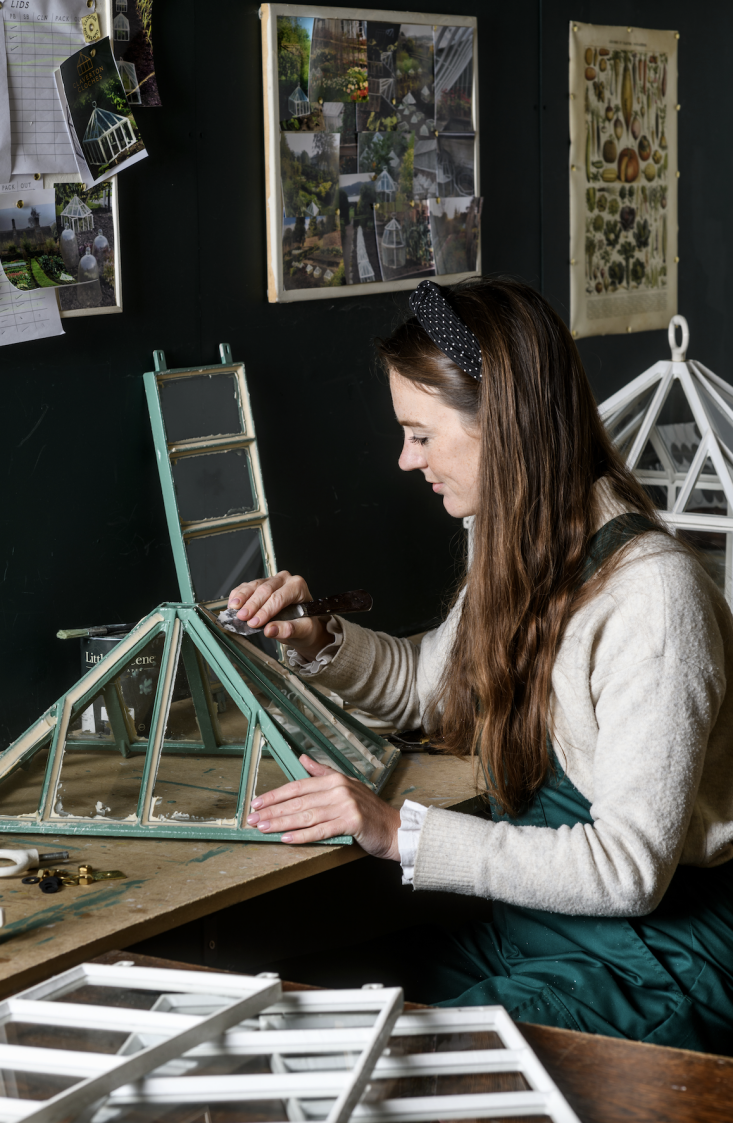When Beth Gregg and her partner Janus Intelmann were hunting for antique cloches to use in their own small garden in Bath back in 2020, they soon realized that few of those surviving cloches had stood the test of time. So they decided to try and make their own.
Armed with a Victorian cloche bought at auction and another from a neighbor, Janus created a new prototype based on these original iron and glass designs. They looked for a foundry that could make the cast iron structure and placed a minimum order for ten. After painting and glazing, they sold them all on Instagram—and soon found themselves starting their business, Claverton Cloches, from a spare room at home.
It didn’t take long for them to outgrow that tiny room. With a burgeoning order list, they moved to a larger studio, and then last year they relocated again to a bucolic stone barn just outside Bath. Here in their workshop, surrounded by rolling fields and herds of bleating sheep, they glaze, putty, and finish each of their cloches. The couple have now introduced a new shape, an octagonal cloche, with plans for more designs. Recently, we caught up with Beth to find out how they’ve built a business from these charming garden accessories.
Photography courtesy of Claverton Cloches except where noted.

With no design experience, but a shared love of craft, Beth and Janus experimented a lot to refine their original prototype. “Janus sketched out the cloches over and over again, studying each angle and corner in minute detail before modeling it in 3D on the computer, whilst teaching himself to use the software at the same time,” explains Beth. “We then bought a small 3D printer, and printed the designs in plastic first to understand how the glass and putty would fit into the frame. Again, the glass cutting and puttying skills are all self-taught.”


Each detail is considered. The sleek and functional handle was inspired by a cloche handle at Erddig Hall in Wales. Each panel of glass—32 for the original square cloche— is cut by hand and the panels of the cloche are designed to slot together (for easier shipping), then secured with a copper pin. While the antique cloches are susceptible to rust, Claverton Cloches are galvanized and powder-coated, made to last a lifetime.

Their latest offering—the octagonal cloche with a smaller footprint perfect for small town gardens or those tight on space—proved even more challenging to create. It took nine months to create a prototype, but they weren’t happy with the results so they began again from scratch….twice: “Another hurdle was the ‘floating’ glass joint in the octagonal—two panes of glass butt together, with no putty or metal in between, so the tolerance for error is low, and the glass edge has to be sanded to the correct angle so it is smooth to touch—but it was worth it for the lightness it provides.”

The cloche is effectively a mini greenhouse (the original square Victorian cloche can be stacked to bring on taller plants including tomatoes and chillies) that allows gardeners to extend the season and grow many more plants. It can help warm up the soil early in the season to get seeds going and then creates a microclimate to help young plants grow, providing earlier crops. The cloche will also shelter plants from harsh winds, cold and hungry rabbits.

The company ships to England, Europe, and the US. In addition to producing cloches in bespoke colors (at an additional cost), Claverton has launched a restoration service for antique cloches. Next up for the business is a larger square cloche that will hopefully launch next year. The pair are working on a handblown glass cloche, too.”These are more delicate than the cast-iron cloches, but I think add a whimsical touch to a garden.”
See also:
- Is It Too Early to Start Planting? How to Know When to Plant Your Cool Weather Crops
- Garden Hacks: 10 Genius Ideas to Keep Plants Warm in Winter
- Hardscaping 101: Cold Frames









Have a Question or Comment About This Post?
Join the conversation